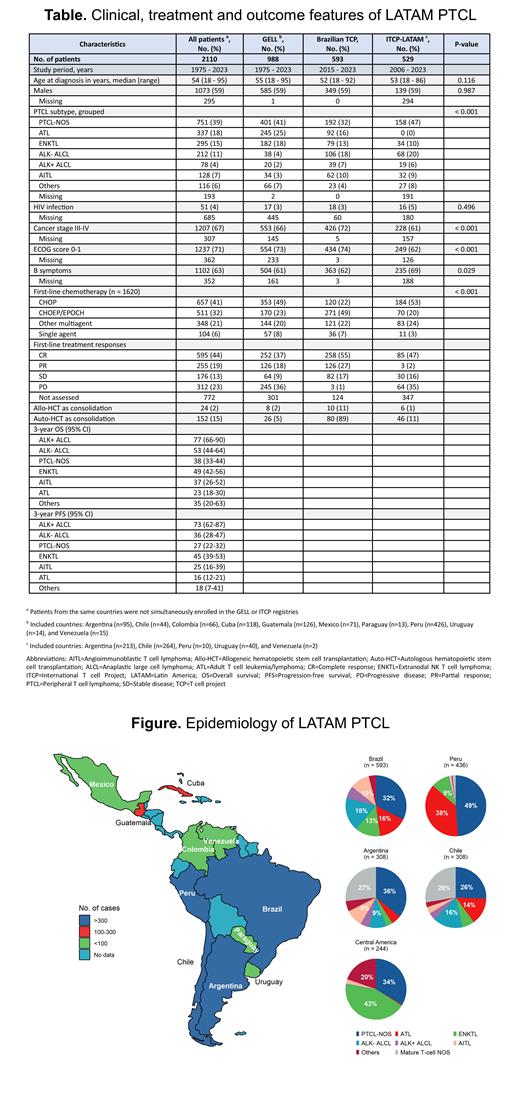INTRODUCTION: Peripheral T-cell lymphomas (PTCL) represent a rare and heterogenous group of mature T-cell lymphomas often characterized by aggressive behavior. Previous studies evaluating the distribution of PTCL subtypes across Latin America (LATAM) were limited in their representation of most countries in the region. Additionally, a lack of standardized management for several subtypes and the absence of comprehensive lymphoma registries in LATAM suggests exploring real-world treatment patterns and clinical outcomes. We conducted an international pooled analysis to assess the distribution of PTCL across LATAM countries and report treatment outcomes.
METHODS: We compiled data from patients aged ≥18 years with newly diagnosed PTCL from the retrospective registry of the Grupo de Estudio Latinoamericano de Linfoproliferativos (GELL, n=988, 1975-2023), the Brazilian T-cell Project (Brazilian TCP, 2015-2017, 168 cases retrospective; 2017-2023, 425 cases prospective) and the prospective registry of the International T cell Project (ITCP, n=529, 2006-2023). Data were abstracted from medical records in a standardized form. Survival data was only available from the GELL and Brazilian TCP. Overall survival (OS) was estimated from diagnosis to death from any cause, while progression-free survival (PFS) was defined from diagnosis to relapse, progression, or death from any cause. We used the Kaplan-Meier method and Log-rank test to estimate and compare survival probabilities.
RESULTS: We enrolled 2110 patients from 11 LATAM countries. Overall, the median age at diagnosis was 54 years (range 18-95 years), most were male (59%), present with advanced stage disease (Ann Arbor III-IV, 67%), and had good performance status (ECOG ≤1, 71%) (Table 1). After PTCL not otherwise specified (NOS, 39%), adult T-cell leukemia/lymphoma (ATL, 18%) and extranodal NK/T cell lymphoma (ENKTL, 16%) were the most frequently diagnosed PTCL subtypes with varying distribution across LATAM countries. Peru had a higher prevalence of ATL (39%) and ENKTL was frequently diagnosed in Central America (43%). In contrast, ALK-negative (ALK-) anaplastic large T-cell lymphoma (ALCL) was the second more frequent subtype in Brazil (18%), Chile (16%), and Argentina (9%). The percentage of mature T-cell NOS was 27% in Argentina and 28% in Chile. A total of 1620 received chemotherapy. First-line chemotherapy varied across subtypes. Patients with ENKTL were frequently treated with asparaginase/platinum-based therapy (62%), while CHOP was more commonly used for ATL or PTCL NOS (46% for both). Chemotherapy with CHOEP/EPOCH was frequent for patients with ALK- ALCL (45%), ALK+ (ALCL 47%), or AITL (48%).
With a median follow-up of 33 months, the 3-year OS and PFS for the overall cohort were 40% and 30%, respectively. ALK+ ALCL had superior survival estimates, with a 3-year OS of 77% and a 3-year PFS of 73%. The 3-year OS for patients with ENKTL was 48% and the PFS was 45%. Patients with ATL experienced the lowest survival rates (OS and PFS of 23% and 16% at 3 years, respectively). The use of asparaginase/platinum or CHOP-based therapy was associated with superior 3-year OS (61% and 52%, respectively; p=0.011) and PFS (57% and 49%, respectively; p=0.017) among patients with ENKTL. For ATL, the use of CHOEP/EPOCH was associated with improved 3-year OS (21%, p=0.009) and PFS (15%, p=0.024), but outcomes remained dismal.
CONCLUSION: To our knowledge, we report the largest pooled cohort of PTCL subtypes across LATAM by leveraging the retrospective registry of the GELL consortium and data from the Brazilian TCP and ITCP. Our findings suggest a distinct distribution of PTCL subtypes across LATAM countries, with a higher prevalence of ATL and ENKTL compared to the epidemiological patterns in Western countries. This distribution underscores a unique opportunity to increase trial enrollment and accrual of rarer PTCL subtypes. The relatively high percentage of mature T-cell NOS suggests difficulties in providing specific lymphoma diagnoses in the region. The low survival rates for some subtypes indicate the need to develop novel therapies to improve patient outcomes. A larger prospective assessment of PTCL epidemiology and treatment outcomes is being planned to expand the ascertainment of cases, improve pathological classification of the different PTCL subtypes, and validate our results in the LATAM region.
Disclosures
Peña:Janssen: Other: Congress Travel expenses. Gazitua:BMS: Speakers Bureau; Pfizer: Other: Travel; MSD: Research Funding; Roche: Other: Travel; Non-remunerated activity. Enrico:Pfizer: Honoraria. Rojas:Roche: Other: Personal Fees; AstraZeneca: Other: Personal Fees; Janssen: Other: Personal Fees; Novartis: Other: Personal Fees. Chiattone:ROCHE, ABBVIE, JANSSEN, AZ, LYLLI, TAKEDA: Honoraria; ROCHE, ABBVIE, JANSSEN, AZ, LYLLI, TAKEDA: Consultancy.


